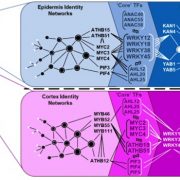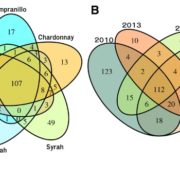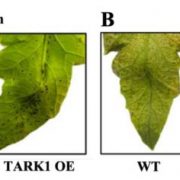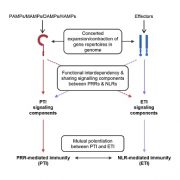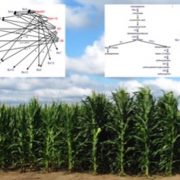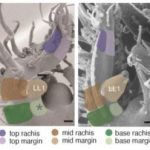A role for melatonin in the defence of sweet oranges against citrus greening disease
If you regularly enjoy a cold glass of orange (Citrus × sinensis) juice, freshly squeezed or store-bought (who has time for the former, really?), then you should know that the future of this drink is at stake. Citrus greening disease or Huánglóngbìng (HLB) has been wreaking havoc on the citrus industry worldwide for decades (Bové, 2006). This disease of citrus trees is wrought by a genus of bacteria named Candidatus Libiribacter, borne by psyllids, small plant-feeding insects. In Florida, the outright majority of orange trees are affected by HLB, which damages the tree, reduces yield, and renders oranges sour and green at the bottom (Dala-Paula et al., 2019). The disease is on the rise from California to Brazil and is likely to be exacerbated by climate change (Alves et al., 2020).
Plants, including citrus trees, have a range of defence mechanisms against pathogens, which are orchestrated by signalling molecules known as phytohormones (plant hormones). These molecules are small organic compounds that occur at exceedingly low concentrations but manage to coordinate physiological processes throughout the plant. Nehela and Killiny (2020) address the role of melatonin, a naturally occurring phytohormone, in the citrus response to HLB. They have focused their efforts on the ‘Valencia’ sweet orange (Citrus x sinensis). In this case, the pathogen is the heat-tolerant Candidatus L. asiaticus and its insect vector, Diaphorina citri, which together, execute HLB disease.
Melatonin (N-acetyl-5-methoxytryptamine) is ubiquitously spread across all kingdoms of life and is prominently thought of as a sleep regulator in humans. In plants, melatonin has principally been considered an antioxidant, controlling the pool of reactive oxygen and nitrogen species. A body of work has revealed its role in multiple physiological processes, such as growth, rooting, photosynthesis, fruit maturation, and protection against abiotic and biotic stressors (reviewed in Arnao and Hernández-Ruiz, 2019.) The recent identification of a plant melatonin receptor solidified its status as a phytohormone (Wei et al., 2018).
 In the paper by Nehela and Killiny, the authors detected endogenous melatonin for the first time in citrus leaves and investigated its role in plant defence. HLB pathogenesis and plant response are difficult to characterize, as the disease is delivered in a one-two punch. Insects feeding on the phloem lead to wounding and incite the necrotrophic defence pathway, mediated by jasmonic acid (JA) and ethylene. The bacteria are delivered from the salivary glands of the insect, inducing a biotrophic response mediated by salicylic acid (SA). The nature of the crosstalk between these two responses has long been debated, and at times can appear antagonistic (Petersen et al., 2000) or synergistic (Schenk et al., 2000). The current work sheds some light on the role of melatonin in plant defence and its association with both pathways (Figure 1).
In the paper by Nehela and Killiny, the authors detected endogenous melatonin for the first time in citrus leaves and investigated its role in plant defence. HLB pathogenesis and plant response are difficult to characterize, as the disease is delivered in a one-two punch. Insects feeding on the phloem lead to wounding and incite the necrotrophic defence pathway, mediated by jasmonic acid (JA) and ethylene. The bacteria are delivered from the salivary glands of the insect, inducing a biotrophic response mediated by salicylic acid (SA). The nature of the crosstalk between these two responses has long been debated, and at times can appear antagonistic (Petersen et al., 2000) or synergistic (Schenk et al., 2000). The current work sheds some light on the role of melatonin in plant defence and its association with both pathways (Figure 1).
Firstly, the authors determined that melatonin content in citrus leaves is induced by Ca. L. asiaticus bacterial infection, rather than the insect vector, D. citri. Melatonin biosynthetic genes are also exclusively upregulated by bacterial infection. Similarly, bacterial infection led to a higher concentration of SA in leaves. Conversely, insect infestation induced the JA necrotrophic pathway, while bacterial infection alone did not have a significant impact. On this basis, melatonin is strongly associated with the SA, biotrophic pathway, rather than the JA response to wounding.
The authors also studied the effect of melatonin independent of the pathogen. They supplemented unaffected citrus trees with melatonin at various concentrations. The application of low levels of melatonin (0.05-0.1 mM) was sufficient to induce the expression of melatonin biosynthetic genes. The self-regulatory role of melatonin is consistent with previous research (Wei et al., 2018). Furthermore, melatonin supplementation at the same low concentrations enhanced the content of four other phytohormones: salicylates (including SA), auxins, JA, and abscisic acid (ABA) and their cognate genes. The induction of the necrotrophic response (JA) is surprising, as the same does not happen when melatonin levels are raised by bacterial infection.
Melatonin supplementation upregulated the transcript levels of many genes involved in defence response and hormone biosynthesis, including an impressive 12.6-fold increase in the expression of Chorismate synthase. The enzyme chorismate synthase (CS) catalyzes the last step in the shikimate pathway to produce chorismate, used for the biosynthesis of tryptophan, phenylalanine, and tyrosine. CS is a veritable hub of phytohormone biosynthesis: tryptophan is the precursor of auxins and melatonin, while phenylalanine is the precursor for SA. Both amino acids are also precursors for a gamut of specialized metabolites, including indole alkaloids and anthocyanins, many of which play a role in plant defence.
The immunomodulatory role of melatonin is also seen in natural varieties of citrus. Higher levels of endogenous melatonin and SA in Citrus latipes and Mexican lime were associated with improved tolerance against Ca. L. asiaticus (Nehela and Killiny, 2020). Introducing such natural traits, by hybrid crosses, into sweet oranges would be an arduous task that could be accelerated by identifying the appropriate molecular targets and editing the genome. However, the last step is unlikely to be received favourably by consumers, raising the stakes in the hunt for HLB cures.
Nehela and Killiny also investigated the possibility that melatonin serves an antimicrobial role against Ca. L. asiaticus. Melatonin supplementation, at low levels (0.05-0.1 mM), reduced bacterial titers in HLB-affected citrus leaves. Unfortunately, the inhibitory role of melatonin against Candidatus L. spp. cannot be directly quantified, as these species are not amenable to culturing. Promisingly, the inhibitory activity of melatonin has been shown against several phytopathogenic fungi in cultured media (Arnao and Hernández-Ruiz, 2015).
Currently, there is no cure for HLB-affected citrus trees, except for control of the psyllids and attempts at boosting the plant immune system. Naturally occurring molecules such as melatonin could be part of a “silver bullet” defence against the scourge of HLB disease and other microbial or viral pathogens. The work by Nehela and Killiny emphasizes the utility of plant-derived melatonin as a biostimulator and protective agent, which can be applied to crops. Translation of this work into agricultural advances that might save your morning glass of OJ will require close analysis of the pleiotropic effects of melatonin and its inextricable link to SA activity.
Mehran Dastmalchi
McGill University
ORCID: 000-0001-5693-6324
LITERATURE CITED
Alves KS, do Carmo LHM, Del Ponte EM (2020) Spatiotemporal spread of huanglongbing in commercial citrus orchards of Minas Gerais, Brazil. Trop Plant Pathol doi: 10.1007/s40858-020-00398-x
Arnao MB, Hernández-Ruiz J (2019) Melatonin: A New Plant Hormone and/or a Plant Master Regulator? Trends Plant Sci 24 (1): 38-48
Arnao MB, Hernández-Ruiz J (2015) Functions of melatonin in plants: a review. J Pineal Res 59 (2): 133-150
Bové JM (2006) Huanglongbing: A destructive, newly-emerging, century-old disease of citrus. J Plant Pathol 88 (1): 7-37
Dala-Paula BM, Plotto A, Bai J, Manthey JA, Baldwin EA, Ferrarezi RS, Gloria MBA (2019) Effect of huanglongbing or greening disease on orange juice quality, a review. Front Plant Sci doi: 10.3389/fpls.2018.01976
Nehela Y, Killiny N (2020) Melatonin is involved in citrus response to the pathogen Huanglongbing via modulation of phytohormonal biosynthesis. Plant Physiol doi: https://doi.org/10.1104/pp.20.00393
Petersen M, Brodersen P, Naested H, Andreasson E, Lindhart U, Johansen B, Nielsen HB, Lacy M, Austin MJ, Parker JE, et al (2000) Arabidopsis MAP kinase 4 negatively regulates systemic acquired resistance. Cell 103 (7): 1111–1120
Schenk PM, Kazan K, Wilson I, Anderson JP, Richmond T, Somerville SC, Manners JM (2000) Coordinated plant defense responses in Arabidopsis revealed by microarray analysis. Proc Natl Acad Sci U S A 97 (21): 11655-11660
Wei J, Li D-X, Zhang J-R, Shan C, Rengel Z, Song Z-B, Chen Q (2018) Phytomelatonin receptor PMTR1-mediated signaling regulates stomatal closure in Arabidopsis thaliana. J Pineal Res 65 (2): e12500


